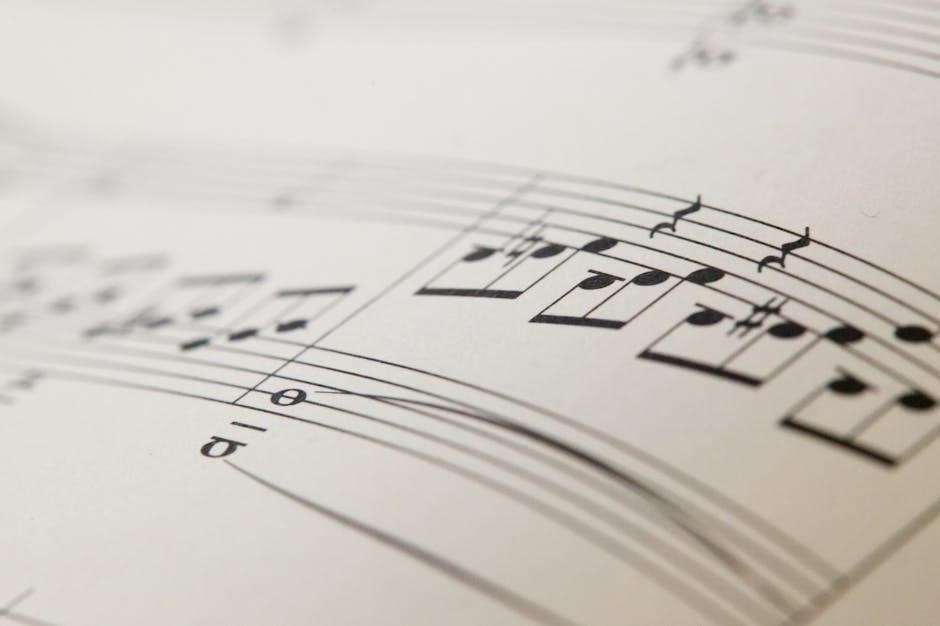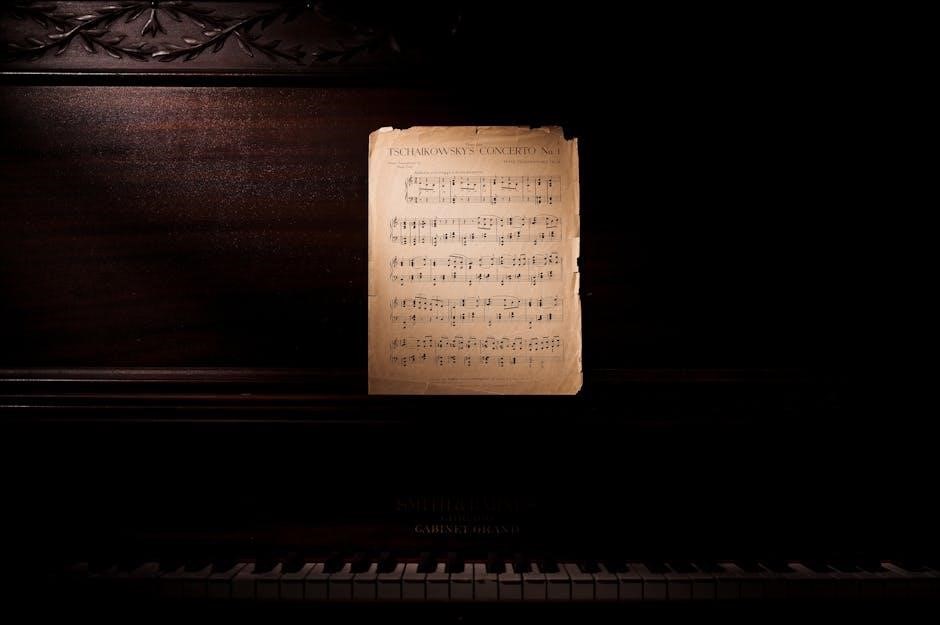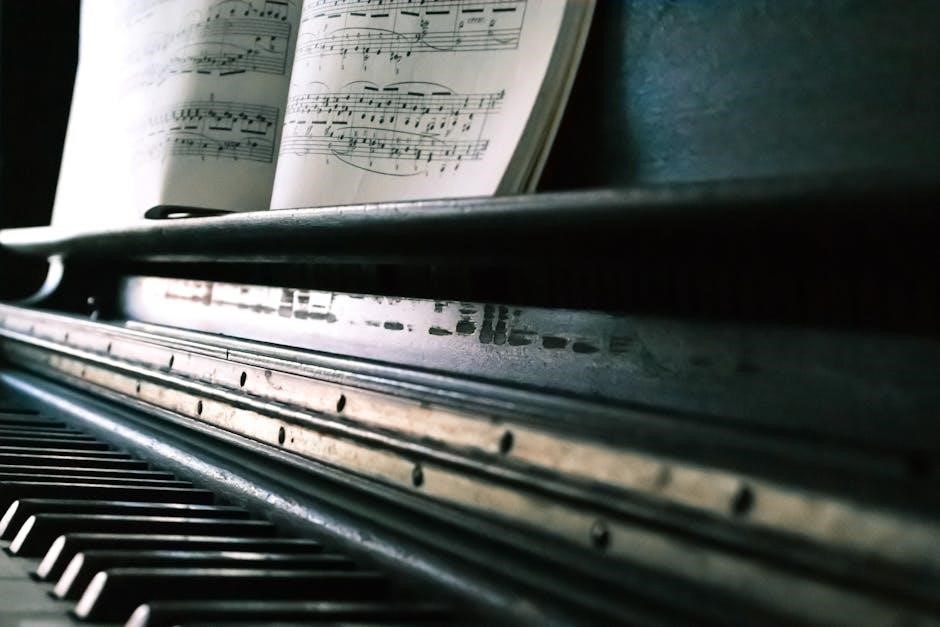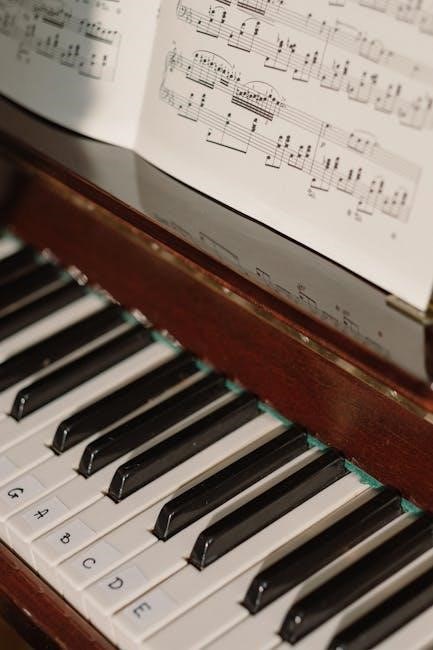Discover the timeless beauty of Ave Maria, a beloved composition by Franz Schubert and famously arranged by Charles Gounod. This iconic piece, known for its serene melody and emotional depth, is now accessible in PDF format for pianists of all skill levels. Whether you’re a beginner or an advanced player, the piano sheet music offers a chance to connect with this cherished work, blending simplicity with harmonic richness. Explore and download your preferred version today, ensuring a captivating performance every time.
Overview of the Piece
Ave Maria is a timeless, emotionally profound composition that has captivated audiences worldwide. Its serene melody and rich harmonies make it a favorite among pianists and music enthusiasts alike. Originally composed by Franz Schubert as Ellens dritter Gesang, it was later arranged by Charles Gounod, blending it with Bach’s Prelude in C Major. The piece is known for its lyrical simplicity and deep expressiveness, making it accessible to pianists of all skill levels while maintaining its artistic integrity. The PDF sheet music offers a clear, structured format, perfect for both personal enjoyment and professional performance.
Significance of the Composition
Ave Maria holds a special place in musical history, revered for its spiritual depth and universal appeal. Schubert’s original composition, Ellens dritter Gesang, was written in 1825 and later arranged by Gounod, creating a version that became iconic in its own right. The piece transcends cultural and religious boundaries, often featured in ceremonies, films, and performances. Its enduring popularity stems from its ability to evoke profound emotion, making it a staple in both classical and contemporary repertoires. The PDF sheet music ensures its legacy continues, allowing pianists to connect with this masterpiece seamlessly.

Background and History of “Ave Maria”
Ave Maria was originally composed by Franz Schubert in 1825 as Ellens dritter Gesang, part of his Seven Songs from Walter Scott’s Lady of the Lake. It gained fame through Charles Gounod’s arrangement, blending Schubert’s melody with Bach’s Prelude in C Major. This harmonious fusion created a timeless classic, cherished for its spiritual and emotional resonance, making it a staple in classical music repertoire.
Composer: Franz Schubert and Charles Gounod
Franz Schubert, an Austrian composer, originally wrote Ellens dritter Gesang in 1825, which later became known as Ave Maria. Charles Gounod, a French composer, famously arranged Schubert’s melody over Johann Sebastian Bach’s Prelude in C Major. This unique collaboration, though unintended, created a timeless piece. Schubert’s version was part of his Seven Songs from Walter Scott’s Lady of the Lake, while Gounod’s arrangement transformed it into a beloved sacred work. Both composers’ contributions have made Ave Maria a cherished piece in classical music, with its piano arrangements remaining popular for all skill levels.
Origins and Evolution of the Piece
Ave Maria originated as Franz Schubert’s Ellens dritter Gesang in 1825, part of his Seven Songs from Walter Scott’s Lady of the Lake. The melody gained fame when Charles Gounod arranged it over Johann Sebastian Bach’s Prelude in C Major. This unintended collaboration created a timeless sacred work. Over the years, the piece has evolved into various arrangements, including piano solo versions, making it accessible to pianists of all levels. Its versatility and emotional depth have cemented its place in classical music, with modern adaptations continuing to inspire new interpretations.

Piano Arrangements and Versions
Ave Maria offers a variety of piano arrangements, from Schubert’s original to Gounod’s adaptation, each maintaining the piece’s elegance and emotional depth for pianists of all levels.
Schubert’s Original Version
Franz Schubert’s original Ave Maria (D. 839) is a lyrical vocal piece, later transcribed for piano. Its gentle melody and harmonious structure make it a favorite among pianists. The original version, set at a Grade 6 level, suits intermediate to advanced players. Available in PDF, it features delicate textures and introspective arrangements. Free and premium scores offer clarity, allowing pianists to practice and perform this timeless piece with ease and emotion, capturing its serene and expressive qualities.
Gounod’s Arrangement
Charles Gounod’s arrangement of Ave Maria is a popular adaptation, set to Bach’s Prelude in C Major. This version features Gounod’s iconic melody, harmonizing with Bach’s original structure. Available in PDF, it offers a beautiful blend of Baroque and Romantic styles. Suitable for intermediate to advanced pianists, Gounod’s arrangement maintains the piece’s spiritual essence while adding intricate harmonies. Free and premium scores provide clear notation, allowing pianists to embrace the emotional depth and elegance of this beloved adaptation, making it a staple in piano repertoire for both practice and performance;
Modern Interpretations and Adaptations

Ave Maria continues to inspire modern pianists and arrangers, with contemporary interpretations offering fresh perspectives. Elaine Kelkel and Ewwas17 have created unique arrangements, blending traditional elements with modern flair. These adaptations often feature simplified harmonies or innovative transcriptions, making the piece accessible to a wider audience. Digital tools and MIDI files have also revolutionized how pianists engage with the music, allowing for personalized transpositions and practice aids. These modern versions ensure Ave Maria remains relevant, catering to diverse skill levels and musical preferences while preserving its timeless elegance and spiritual essence.

Downloading “Ave Maria” Piano Sheet Music PDF
Access Ave Maria piano sheet music in PDF format from trusted sources like Easypianoscores.com and MutopiaProject.org. Download free or premium scores, featuring arrangements by Elaine Kelkel and more.
Free Resources and Websites
Discover free Ave Maria piano sheet music on sites like MutopiaProject.org, which offers flexible licensing, and FreeSheetPianoMusic.com, featuring MIDI files and practice tools. Easypianoscores.com provides easy arrangements for all skill levels. These platforms support pianists globally, offering high-quality resources for practice and performance. While they may lack the detail of premium versions, they are excellent for learning and enjoyment, allowing you to explore the piece’s beauty with ease and connect with a community of musicians.
Premium and High-Quality Scores
Premium Ave Maria piano scores offer exceptional clarity and accuracy, ideal for serious pianists. Platforms like 8notes Premium provide meticulously transcribed PDFs, ensuring precision and detail; These high-quality scores often include additional resources, such as MIDI files, practice videos, and the ability to transpose the piece into different keys, enhancing your learning experience.
Investing in premium sheet music guarantees a polished and professional performance, making it a worthwhile choice for those seeking to master this timeless piece. These scores are available for immediate download, ensuring you can start practicing without delay. They are perfect for pianists looking to elevate their interpretation of Ave Maria.
How to Print and Use the Sheet Music
Once you’ve downloaded the Ave Maria piano sheet music PDF, printing it is straightforward. Ensure your printer is set to high-quality settings for clear notation. Use standard letter-sized paper (8.5×11 inches) for optimal readability. For a professional touch, consider printing on high-quality paper or cardstock. After printing, bind the sheets together for easy handling during practice or performance.
Review the sheet music before playing to familiarize yourself with the layout and any markings. Use a music stand or digital device for convenient access. Adjust the zoom or formatting if needed for better visibility. This ensures a seamless and enjoyable experience when playing Ave Maria.

Playing “Ave Maria” on the Piano
Mastering Ave Maria on the piano requires a balance of technical skill and emotional expression. Start with a slow tempo to ensure accuracy, gradually increasing speed. Focus on dynamics and phrasing to convey the piece’s serene beauty. Practice hand positioning and finger dexterity for smooth transitions between notes. Pay attention to pedaling techniques to enhance resonance and depth, bringing this timeless melody to life with elegance and passion.
Beginner-Friendly Arrangements
Beginners can enjoy playing Ave Maria with simplified arrangements that maintain the piece’s beauty while reducing complexity. These versions often feature slower tempos and fewer intricate harmonies, making them accessible. Many free resources, such as those from MutopiaProject.org, offer adaptable sheet music tailored for learners. Some arrangements, like the Grade 6-level piece, provide a gentle introduction to the melody’s lyrical qualities. With practice, even novice pianists can master these arrangements, connecting with the emotional depth of Schubert’s timeless composition. These adaptations ensure a smooth transition from basic skills to more advanced techniques.
Intermediate to Advanced Techniques
For intermediate to advanced pianists, Ave Maria offers opportunities to explore intricate harmonies and expressive techniques. Players can delve into dynamic variations, nuanced pedaling, and articulate phrasing to enhance the piece’s emotional impact. Advanced arrangements often incorporate complex fingerwork and ornamentation, challenging even seasoned musicians. Resources like MutopiaProject.org provide detailed sheet music with advanced interpretations, allowing pianists to refine their skills. These versions emphasize the original composition’s depth, inviting performers to add their personal touch while maintaining the piece’s timeless elegance and spiritual essence.
Practice Tips and Performance Advice
Mastering Ave Maria requires attentive practice and a focus on expression. Begin by practicing at a slower tempo to build confidence and accuracy. Utilize practice loops or MP3 resources to refine challenging sections. Pay special attention to dynamics and phrasing, as these elements enhance the piece’s emotional depth. Experiment with pedaling techniques to achieve a lush, resonant sound. For performance, maintain a steady tempo and emphasize lyrical melodies. Consider seeking feedback from a teacher or mentor to refine your interpretation. Regular practice will ensure a captivating and heartfelt rendition of this beloved classic.

Cultural and Religious Significance
Ave Maria holds profound cultural and religious significance, often performed in ceremonies and rituals. Its serene melody and sacred origins make it a timeless, universally cherished piece.
Lyrics and Latin Adaptations
The original Ave Maria by Schubert was composed to the German poem Ellens dritter Gesang, but its adaptation to the Latin prayer Ave Maria has become iconic. The Latin lyrics, such as “Ave Maria, gratia plena”, resonate deeply, aligning perfectly with the melody’s sacred essence. This adaptation transforms the piece into a powerful spiritual hymn, often used in religious ceremonies. The Latin version emphasizes the prayerful nature of the composition, making it a staple in both liturgical and classical music traditions. Its universal appeal endures, transcending linguistic boundaries.
Use in Ceremonies and Rituals
Ave Maria is a cornerstone in various ceremonies and rituals due to its serene and sacred qualities. Frequently featured in weddings, funerals, and religious services, the piece evokes profound emotion, making it a popular choice for creating a contemplative atmosphere. Its universal appeal allows it to transcend specific events, fitting seamlessly into liturgical and secular settings alike. The availability of piano sheet music in PDF format ensures accessibility for performers across diverse ceremonial contexts, enhancing its role as a timeless accompaniment to life’s most meaningful moments.
Modern Popularity and Performances
Ave Maria remains a timeless favorite in modern performances, frequently featured in concerts, weddings, and films. Its emotional resonance and versatility make it a staple in both classical and contemporary settings. Pianists worldwide continue to interpret the piece, leveraging its expressive qualities to connect with audiences. The availability of piano sheet music PDFs has further amplified its reach, allowing artists to easily access and perform this beloved composition. Its enduring appeal ensures that Ave Maria remains a cherished piece in modern musical repertoire.

Comparing Different Versions
Explore the diverse interpretations of Ave Maria, from Schubert’s original vocal piece to Gounod’s iconic melody over Bach’s prelude. Modern adaptations offer fresh perspectives, catering to various skill levels and stylistic preferences, ensuring this timeless composition remains universally cherished.
Schubert vs. Gounod Arrangements
Schubert’s original Ave Maria was composed for voice and piano, part of his Ellens Gesang III, while Gounod famously added his melody over Bach’s Prelude in C. Schubert’s version remains a delicate, introspective piece, emphasizing vocal expression. In contrast, Gounod’s arrangement transforms it into a grand, harmonically rich piano work, often mistaken as Schubert’s original. Both versions are cherished, but Gounod’s adaptation is widely recognized for its emotive depth and technical complexity, making it a favorite among pianists seeking a challenging yet beautiful performance piece.
Differences in Melody and Harmony
The Schubert and Gounod arrangements of Ave Maria showcase distinct melodic and harmonic traits. Schubert’s original version features a delicate, flowing melody accompanied by a simple yet elegant piano harmony, preserving the piece’s intimate nature. Gounod’s arrangement, however, introduces a more elaborate melody overlaid on Bach’s Prelude in C, creating a richer, more complex harmonic structure. While Schubert’s version remains delicate and straightforward, Gounod’s adaptation adds depth with intricate arpeggios and counterpoint, making it a technically challenging yet emotionally rewarding interpretation for pianists.
Choosing the Right Version for Your Skill Level
Selecting the appropriate version of Ave Maria piano sheet music depends on your skill level. Beginners may prefer simplified arrangements with basic melodies and straightforward harmonies, ensuring an enjoyable learning experience. Intermediate pianists can explore Schubert’s original version or Gounod’s arrangement, which offer moderate complexity. Advanced players may opt for intricate adaptations featuring elaborate arpeggios and counterpoint. By choosing a version that aligns with your abilities, you can master the piece effectively and appreciate its timeless beauty. This ensures a rewarding experience for pianists at every stage.

Advanced Techniques and Interpretations
Advanced pianists can explore intricate dynamics, nuanced phrasing, and expressive pedaling to elevate their performance of Ave Maria. These techniques add depth and emotion, transforming the piece into a captivating musical experience.
Articulation and Dynamics
Mastering articulation and dynamics is essential for a compelling performance of Ave Maria. Use legato phrasing to maintain the melody’s flow, while employing staccato touches for lighter passages. Dynamics play a crucial role in expressing the piece’s emotional depth—gradually increasing volume during crescendos and softly diminishing during decrescendos. Pay attention to contrasting sections, where sudden shifts from pianissimo to mezzo-forte can highlight dramatic moments. Balancing these elements ensures a rich, expressive interpretation that resonates with listeners and stays true to the composition’s timeless elegance.

Pedaling and Expression
Pedaling and expression are vital for achieving the ethereal quality of Ave Maria. Use the sustain pedal to create a lush, resonant sound, blending chords and melodies seamlessly. Apply subtle variations in tempo rubato to enhance emotional expression, allowing the melody to breathe naturally. The sostenuto pedal can sustain bass notes while the treble voices sing freely, adding depth and clarity. Experiment with dynamic contrasts and pedaling techniques to convey the piece’s spiritual essence, ensuring a performance that is both technically precise and deeply moving.
Personalizing the Performance
Personalizing your performance of Ave Maria allows you to infuse the piece with your unique interpretation. Consider experimenting with tempo rubato, subtly adjusting the pace to convey emotional depth. Dynamics play a crucial role; soften delicate passages to create intimacy, then swell in fortissimo sections for dramatic impact. Phrasing can be tailored to highlight the lyrical qualities of the melody. Whether you choose Schubert’s original or Gounod’s arrangement, embrace the emotional essence of the piece to connect deeply with your audience, making each performance a reflection of your artistic voice.
Ave Maria remains a timeless piece, offering pianists a chance to connect with its serene beauty and emotional depth. Explore its various arrangements and interpretations to find your perfect version, ensuring a meaningful and captivating performance every time.
Impact of “Ave Maria” on Piano Repertoire
Ave Maria has profoundly influenced piano repertoire, offering a versatile and emotionally resonant piece for pianists worldwide. Its timeless melody, crafted by Schubert and immortalized by Gounod, bridges classical and contemporary music, making it a staple in both worship and secular performances. The piece’s adaptability to various skill levels ensures its enduring popularity, inspiring countless adaptations and interpretations. As a result, Ave Maria remains a cherished and integral part of piano literature, continuing to captivate audiences and musicians alike with its serene beauty and emotional depth.
Encouragement for Pianists to Explore
Pianists of all levels are encouraged to explore the timeless beauty of Ave Maria, as its versatility offers something for everyone. Whether you’re a beginner seeking a heartfelt melody or an advanced player looking to refine technique, this piece promises growth and fulfillment. Start with simplified arrangements and gradually embrace more complex versions as your skills evolve. Experiment with dynamics, articulation, and expression to make the piece uniquely yours. Embrace the journey of mastering Ave Maria and discover the joy of bringing this beloved composition to life.
Additional Resources for Further Study
For deeper exploration, visit websites like Easypianoscores.com and FreeSheetPianoMusic.com, offering free and premium Ave Maria sheet music. Platforms such as MutopiaProject.org provide downloadable PDFs and MIDI files, along with the freedom to modify and share. Explore LilyPond.org for typesetting tools to create custom arrangements. Utilize practice videos and transpose options on FreeSheetPianoMusic.com to tailor the piece to your needs. These resources empower pianists to refine their skills and interpret Ave Maria with personal flair, ensuring a rich and rewarding musical journey.
